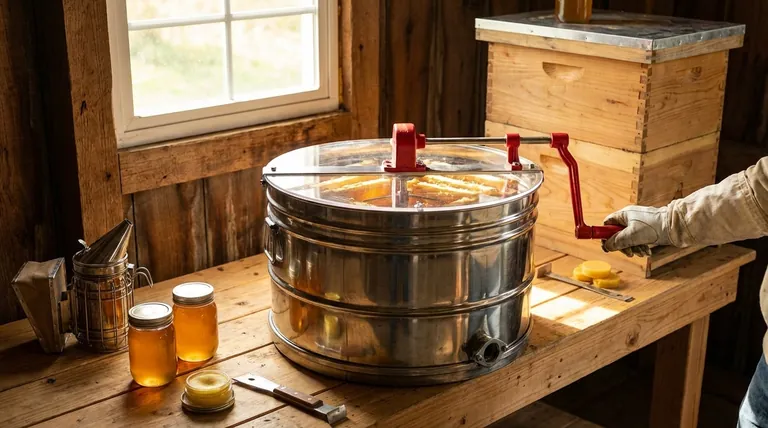For a small bee yard, the most suitable and cost-effective option is a manual, hand-crank tangential extractor. This type of extractor is perfectly sized for the honey volume of 1-4 hives, requires no electricity, and offers the lowest initial investment, making it the ideal starting point for a new or hobbyist beekeeper.
The decision of which extractor to buy is less about finding a single "best" model and more about understanding the fundamental trade-off between your budget, your time, and your future plans for expansion. For most small-scale beekeepers, starting simple is the wisest path.

The Two Core Decisions: Power and Design
Choosing an extractor comes down to two key questions. Answering them will immediately narrow your options from dozens to a select few that fit your needs.
Manual (Hand-Crank) vs. Motorized
The first choice is how you will power the machine.
A manual extractor uses a hand-crank to spin the frames. It is mechanically simple, less expensive, and doesn't require a power source, making it ideal for extracting honey in a shed or barn without electricity.
A motorized extractor uses an electric motor, saving you significant physical effort and time. This becomes a major advantage when you have more than a few hives to process, as hand-cranking can become laborious.
Tangential vs. Radial Design
The second choice is how the extractor orients the frames.
A tangential extractor places the frames like spokes on a wheel, with one side of the comb facing outward. It extracts honey from one side at a time, requiring you to stop, flip the frames manually, and spin again to empty the other side. This design is simpler and most common in smaller, budget-friendly models.
A radial extractor positions the frames with the top bar facing the center, allowing centrifugal force to pull honey from both sides of the comb simultaneously. These are far more efficient and can hold more frames, making them the standard for beekeepers with larger operations.
Understanding the Trade-offs
An extractor is a significant investment. Being aware of the hidden compromises will help you avoid buyer's remorse.
The Cost vs. Labor Equation
The central trade-off is your money versus your effort. A manual tangential extractor is the cheapest option, but it will cost you the most in time and physical labor on harvest day.
For 1-3 hives, the time commitment is manageable. Once you reach 4 or more hives, the time and effort required to hand-crank and flip frames in a tangential extractor increase dramatically.
The "Upgrade Path"
Many beekeepers plan to start small and upgrade later. While this is a viable strategy, remember that a good stainless steel extractor holds its value but can still be a hassle to sell.
If you are confident you will expand to 5+ hives within two seasons, it can be more economical to invest in a small radial extractor from the start.
Material and Build Quality
Pay close attention to the materials. Always prioritize extractors made from food-grade stainless steel. Cheaper models may use plastic or painted steel, which can degrade, rust, or potentially leach chemicals into your honey over time. A stainless steel tank and basket are non-negotiable for long-term safety and durability.
Making the Right Choice for Your Goal
Select your equipment based on a clear-eyed assessment of your current and near-future needs.
- If you have 1-3 hives and a tight budget: A 2- or 4-frame manual tangential extractor is the perfect starting point that will serve you well for years.
- If you have 4-7 hives or plan to expand quickly: A small motorized radial extractor will save you an immense amount of time and is a worthwhile investment.
- If your primary focus is minimizing physical effort: A motorized extractor is the best choice regardless of hive count; the convenience is worth the extra cost.
By aligning your equipment with your specific goals, you ensure your honey harvest is a reward, not a chore.
Summary Table:
| Extractor Type | Best For | Key Features | Considerations |
|---|---|---|---|
| Manual Tangential | 1-3 hives, tight budget | Lowest cost, no electricity needed | Requires manual cranking and frame flipping |
| Motorized Radial | 4+ hives, expanding operations | Saves time and effort, extracts both sides at once | Higher initial investment |
Ready to make your next honey harvest a success? Let HONESTBEE, your trusted wholesale partner for commercial apiaries and beekeeping equipment distributors, provide you with durable, food-grade stainless steel extractors that are built to last. We'll help you select the perfect equipment to match your scale and goals. Contact our expert team today for wholesale pricing and personalized advice!
Visual Guide

Related Products
- HONESTBEE 3-Frame Manual Acrylic Honey Extractor
- Commercial Electric 12 Frame Honey Extractor Spinner Motorized Honey Extractor
- 6 Frame Manual Stainless Steel Honey Extractor Beekeeping Equipment
- Plastic Hand Crank 2 Frame Honey Extractor Low Price
- 8-Frame Electric Self-Reversing Honey Extractor Spinner for Commercial Honey Extraction Equipment
People Also Ask
- How often do beekeepers collect honey? Maximize Your Hive's Sustainable Yield
- Which type of honey extractor is generally more durable? Focus on Material & Build Quality for Longevity
- What size honey extractor do I need? Match Frame Capacity to Your Hives for Maximum Efficiency
- What is the most common method for cleaning a honey extractor? Protect Your Honey & Equipment
- What machines are needed in beekeeping besides basic tools? Scale Your Honey Harvest Efficiently



















